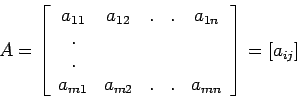
![]()
![]()
Next: Norms of Vectors: Up: Main
![]() if
if ![]()
![]() if
if![]()
![]() denote the space of column vectors with n real components.
denote the space of column vectors with n real components.
![]() denotes the space of column vectors with n complex
components.
denotes the space of column vectors with n complex
components.
Vectors will be denoted by lower case letters. e.g.
if ![]() , then
, then
![\begin{displaymath}a= \left[
\begin{array}{c}
a_1\\
.\\
.\\
a_n\\
\end{array}
\right]\end{displaymath}](img10.png)
where the ![]() are real.
are real.
![]() will denote the
will denote the ![]() unit column vector, all components being zero except the
unit column vector, all components being zero except the ![]() , which is
1 so that
, which is
1 so that
![]() .
.
e will denote the column vector all of whose components
are 1.
A matrix is a rectangular array of numbers in which not
only the value of the number is important but also its position in
the array. The size of the matrix is described by the number of
its rows and columns.A matrix of n rows and m columns is said to
be nxm matrix. Matrices will be denoted by upper case letters.
e.g

![]()
and ![]()
We shall occasionally write ![]() to indicate the
to indicate the ![]() row of
a matrix and similarly
row of
a matrix and similarly ![]() the
the ![]() column of a matrix.
column of a matrix.
The inner product (or scalar product) of two vectors will be denoted by